
Hare Krishna Toilets, Showers, and Sinks
International Society for Krishna Consciousness
What many people simply call the Hare Krishna movement
is, more formally, the
International Society for Kirshna Consciousness,
a relatively new Vaishnava spiritual movement
within Hinduism, more specifically in the
Gaudiya Vaishnava (or Chaitanya Vaishnava)
sect.
The movement operates cafes in several cities.
In New York City I know of two guesthouses that they operate.
My experience, having stayed in one multiple times,
is that ISKCON literature is available in the shared area
and possibly in the small private rooms.
But no one is pushy.
You're invited to take literature.
If you ask, you can hear about it.
But if you don't ask, you won't hear anything.

If you're anxious to get to the toilet pictures, jump ahead:
Tompkins Square Park
Guesthouses
Cafe
Monotheism
Hebrew Bible ToiletsJudaism believes in one God, a being so holy that his name should not be written down.
Islamic Toilet EtiquetteIslam believes in one God, named Allah in Arabic, who is described by 99 names, each describing a attribute or aspect: The All-Compassionate, The Ever-Merciful, The Ever-Tranquil, The Granter of Security, and so on.
Toilets of Christian SitesChristianity believes in one God, but most Christian sects believe that the one God manifests in three forms: Father, Son, and Holy Spirit. Nontrinitarian sects include the Church of Jesus Christ of Latter-Day Saints, commonly known as the Mormons, the Jehovah's Witnesses, and the Christian Scientists, along with less numerous sects. Mormon cosmology teaches that you can become a god and get a planet to rule over.
Hindu Toilet EtiquetteHinduism is also monotheistic. Hinduism believes that there is one true God who may manifest in a large number of diverse forms. Many more than the simple three of Christianity, and quite diverse in form. This one Supreme God is referred to in Sanskrit as Svayam Bhagavan or "The Lord Himself".
Some Christians, despite their concept of the Trinity and three incarnations of the one true Godhead, have a very hard time seeing Hinduism as monotheism. But that is literally how this belief defines itself. Part of the difficulty is due to the number being much larger than just three. Another is probably linguistic, although that's as silly as saying that the French can't be Christians because they worship this mysterious Dieu, and don't even get the Evangelicals started about the Russians and their pagan Bog which they go so far as to spell Бог in their crazy alphabet.
Anxious to jump to the toilet pictures?
Tompkins Square Park
Guesthouses
Cafe
Vaishnava Beliefs
The Rigveda is the oldest Vedic religious text, composed roughly 1700–1100 BCE during the late Bronze Age. It is one of the oldest extant texts in any Indo-European language. The Rigveda describes Lord Vishnu as the Supreme Deity.
Vaishnavism is one of the four major denominations of Hinduism. For the most part, Vaishnavism considers Vishnu to be the supreme being. But Vaishnavism contains sub-sects such as Krishnaism and Ramaism, who believe that Krishna or Rama, respectively, is the Supreme Person of Godhood.
Gaudiya Vaishnavism or Chaitanya Vaishnavism is a Vaishnava movement arising in the 1500s in the Gauḍa region, today's Bengal and Bangladesh. It is based mainly on the Bhagavad Gita and Bhagavata Purana plus other scriptures including the Upanishads. Its traditional origins lie in a series of spiritual masters or gurus, believed to have originated with Brahma himself.
The identification of Krishna as the complete manifestation of God comes from the Bhagavad Gita, Chapter 10:
1
The Supreme Personality of Godhead said: Listen again, O
mighty-armed Arjuna.
Because you are My dear friend, for your benefit I shall
speak to you further, giving knowledge that is better
than what I have already explained.
2
Neither the hosts of demigods nor the great sages know My
origin or opulences, for, in every respect, I am the source
of the demigods and sages.
3
He who knows Me as the unborn, as the beginningless, as the
Supreme Lord of all the worlds — he only, undeluded
among men, is freed from all sins.
4-5
Intelligence, knowledge, freedom from doubt and delusion,
forgiveness, truthfulness, control of the senses, control of
the mind, happiness and distress, birth, death, fear,
fearlessness, nonviolence, equanimity, satisfaction,
austerity, charity, fame and infamy — all these
various qualities of living beings are created by Me alone.
6
The seven great sages and before them the four other great
sages and the Manus [progenitors of mankind] come from Me,
born from My mind, and all the living beings populating the
various planets descend from them.
7
One who is factually convinced of this opulence and mystic
power of Mine engages in unalloyed devotional service;
of this there is no doubt.
8
I am the source of all spiritual and material worlds.
Everything emanates from Me.
The wise who perfectly know this engage in My devotional
service and worship Me with all their hearts.
9
The thoughts of My pure devotees dwell in Me, their lives are
fully devoted to My service, and they derive great
satisfaction and bliss from always enlightening one
another and conversing about Me.
10
The thoughts of My pure devotees dwell in Me, their lives are
To those who are constantly devoted to serving Me with love,
I give the understanding by which they can come to Me.
11
To show them special mercy, I, dwelling in their hearts,
destroy with the shining lamp of knowledge the darkness
born of ignorance.
12-13
Arjuna said: You are the Supreme Personality of Godhead,
the ultimate abode, the purest, the Absolute Truth.
You are the eternal, transcendental, original person, the
unborn, the greatest.
All the great sages such as Narada, Asita, Devala and Vyasa
confirm this truth about You, and now You Yourself are
declaring it to me.
14
O Krishna, I totally accept as truth all that You have told me.
Neither the demigods nor the demons, O Lord, can understand
Your personality.
15
Indeed, You alone know Yourself by Your own internal potency,
O Supreme Person, origin of all, Lord of all beings,
God of gods, Lord of the universe!
16
Please tell me in detail of Your divine opulences by which
You pervade all these worlds.
17
O Krishna, O supreme mystic, how shall I constantly think of
You, and how shall I know You?
In what various forms are You to be remembered,
O Supreme Personality of Godhead?
18
O Janardana, again please describe in detail the mystic power
of Your opulences.
I am never satiated in hearing about You, for the more I hear
the more I want to taste the nectar of Your words.
19
The Supreme Personality of Godhead said: Yes, I will tell you
of My splendorous manifestations, but only of those which are
prominent, O Arjuna, for My opulence is limitless.
20
I am the Supersoul, O Arjuna, seated in the hearts of
all living entities. I am the beginning, the middle and
the end of all beings.
21
Of the Adityas I am Vishnu, of lights I am the radiant sun,
of the Maruts I am Marici, and among the stars I am the moon.
22
Of the Vedas I am the Sama Veda; of the demigods I am Indra, the king of heaven; of the senses I am the mind; and in living beings I am the living force [consciousness].
23
Of all the Rudras I am Lord Siva, of the Yakshas and Rakshasas I am the Lord of wealth [Kuvera], of the Vasus I am fire [Agni], and of mountains I am Meru.
24
Of priests, O Arjuna, know Me to be the chief, Brihaspati. Of generals I am Kartikeya, and of bodies of water I am the ocean.
25
Of the great sages I am Bhrigu; of vibrations I am the transcendental om. Of sacrifices I am the chanting of the holy names [japa], and of immovable things I am the Himalayas.
26
Of all trees I am the banyan tree, and of the sages among the demigods I am Narada. Of the Gandharvas I am Citraratha, and among perfected beings I am the sage Kapila.
27
Of horses know Me to be Uccaihsrava, produced during the churning of the ocean for nectar. Of lordly elephants I am Airavata, and among men I am the monarch.
28
Of weapons I am the thunderbolt; among cows I am the surabhi. Of causes for procreation I am Kandarpa, the god of love, and of serpents I am Vasuki.
29
Of the many-hooded Nagas I am Ananta, and among the aquatics I am the demigod Varuna. Of departed ancestors I am Aryama, and among the dispensers of law I am Yama, the lord of death.
30
Among the Daitya demons I am the devoted Prahlada, among subduers I am time, among beasts I am the lion, and among birds I am Garuda.
31
Of purifiers I am the wind, of the wielders of weapons I am Rama, of fishes I am the shark, and of flowing rivers I am the Ganges.
32
Of all creations I am the beginning and the end and also the middle, O Arjuna. Of all sciences I am the spiritual science of the self, and among logicians I am the conclusive truth.
33
Of letters I am the letter A, and among compound words I am the dual compound. I am also inexhaustible time, and of creators I am Brahma.
34
I am all-devouring death, and I am the generating principle of all that is yet to be. Among women I am fame, fortune, fine speech, memory, intelligence, steadfastness and patience.
35
Of the hymns in the Sama Veda I am the Brihat-sama, and of poetry I am the Gayatri. Of months I am Margasirsha [November-December], and of seasons I am flower-bearing spring.
36
I am also the gambling of cheats, and of the splendid I am the splendor. I am victory, I am adventure, and I am the strength of the strong.
37
Of the descendants of Vrishni I am Vasudeva, and of the Pandavas I am Arjuna. Of the sages I am Vyasa, and among great thinkers I am Usana.
38
Among all means of suppressing lawlessness I am punishment, and of those who seek victory I am morality. Of secret things I am silence, and of the wise I am the wisdom.
39
Furthermore, O Arjuna, I am the generating seed of all existences. There is no being — moving or nonmoving — that can exist without Me.
40
O mighty conqueror of enemies, there is no end to My divine manifestations. What I have spoken to you is but a mere indication of My infinite opulences.
41
Know that all opulent, beautiful and glorious creations spring from but a spark of My splendor.
42
But what need is there, Arjuna, for all this detailed knowledge? With a single fragment of Myself I pervade and support this entire universe.
They believe that consciousness is part of the soul, which is eternal and distinct from its current body. Souls captivated by Maya or the illusory nature of the world are repeatedly reborn in accordance with the laws of karma and individual desire.
The ultimate aim is bhakti or devotional worship in its purest form. This is based on the chanting or singing of Krishna's names.
Gaudiya Vaishnavism began gaining some Western converts starting around 1900 in the United States, and then in the 1930s in England.
Anxious to jump to the toilet pictures?
Tompkins Square Park
Guesthouses
Cafe
Chanting in Tompkins Square Park and the Establishment of ISKCON
Abhay Charan De was born in 1896 in a suburb of Calcutta. He studied at the local Scottish Church College, where he was a member of both the English Society and the Sanskrit Society and graduated in 1920 with majors in English, philosophy and economics. In 1922 he first met the man who would be his spiritual master and guide, Bhaktisiddhanta Sarasvati Thakura, who asked him to spread the message of Gaudiya Vaishnavism in English.
In 1950 Abhay Charan De owned a small pharmaceutical business, was married and had children. He then adopted the lifestyle of a vanaprastha or pious mendicant. In 1959 he took sannyasa or the vow of renunciation, took the sannyasa name of Abhay Charanaravinda Bhaktivedanta Swami Prabhupada, or, in Sanskrit, अभय चरणाऱविनढ भकिवॆढानत सवामी परभुपाढ. He then became a traveling Vaishnava monk.
For what it's worth, Toilet Guru seems to be शौचालय गुर or shauchalya guru in Hindi.
In 1965 he managed to get free passage on the cargo ship Jaladuta, possessing only a suitcase, an umbrella, forty rupees of Indian currency (worth about eight U.S. dollars), some dry cereal, and several boxes of books. He arrived in New York City in September, 1965, and began looking for followers and teaching.
On October 9, 1966, Abhay Charanaravinda Bhaktivedanta Swami Prabhupada and his followers, including Beat poet Allen Ginsberg, sat beneath this large elm tree in Tompkins Square Park and held the first chanting session of the Hare Krishna mantra, also known as the Maha Mantra or "Great Mantra", accompanied with cymbals, tambourines and other percussion instruments, plus dancing, going on for two hours or more.
This was the founding of the International Society of Krishna Consciousness, often abbreviated as ISKCON.
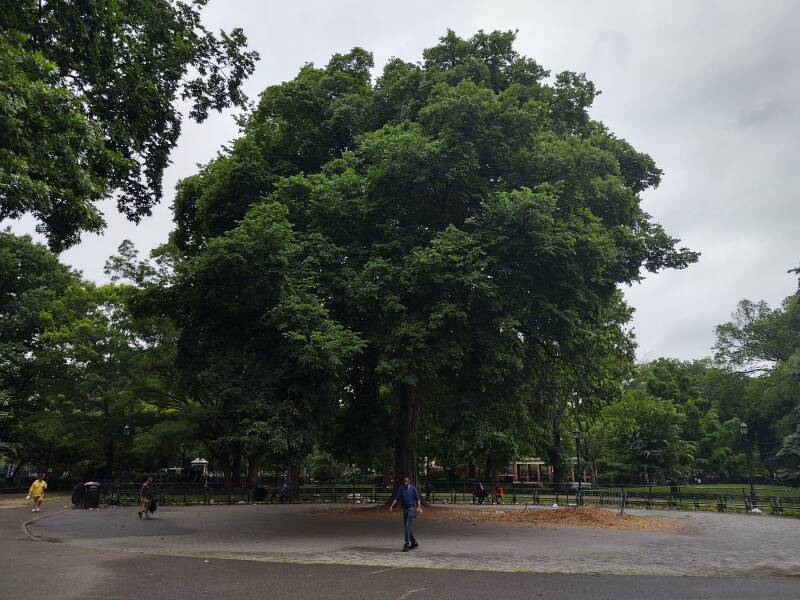
The Hare Krishna Elm in Tompkins Square Park.
This Hare Krishna mantra or Maha Mantra has been important since the 15th century, but it only became well known outside India starting with the establishment of ISKCON or the Hare Krishna movement. The mantra is based on three Sanskrit names for God in the vocative case, in which a noun identifies the person being addressed. That is, it is an expression of direct address. The idea is that the mantra says God's names to God. The names are:
Hare or हरॆ which could be another name of Krishna meaning "He who Removes Illusion", or it could refer to "the energy of God" according to Abhay Charanaravinda Bhaktivedanta Swami Prabhupada.
Krishna or कृष्ण referring to God himself, meaning "He who is All-Attractive."
Rama or राम referring to God himself, meaning "He who is the Source of All Pleasure."
The mantra is repeated, as mantras are, either out loud (a practice called kirtan), softly to oneself (or japa), or silently, thinking the mantra repeatedly without vocalizing it. Sankirtana is street chanting with dancing.
Hare Krishna Hare Krishna
Krishna Krishna Hare Hare
Hare Rama Hare Rama
Rama Rama Hare Hare
हरॆ
कृशण
हरॆ
कृशण
कृशण
कृशण
हरॆ
हरॆ
हरॆ राम
हरॆ राम
राम राम
हरॆ हरॆ
Tompkins Square Park and its Toilets
Tompkins Square Park, the site of this chanting, lies between Avenue A and Avenue B on its west and east, and between 7th Street and 10th Street on its south and north, in the Alphabet City section of what is now called the East Village in Manhattan. It opened as a park in 1850, and has been the site of a number of uprisings through the years. Immigrants protesting unemployment and food shortages were attacked by police in 1857.
The Draft Riots of 1863 were the largest civil insurrection in the United States. The riots started when working-class men, primarily ethnic Irish, protested how wealthy men could pay a $300 commutation fee to hire a substitute and avoid being drafted to fight in the American Civil War. This turned into race riots with white rioters attacking blacks, ransacking and destroying public buildings, and burning the Colored Orphan Asylum at Fifth Avenue and 44th Street to the ground.
The Tompkins Square Riot of 1874 started with a demonstration by over seven thousand unemployed workers. About 1,600 policemen were deployed and forcibly ejected the crowd from the park.
In 1877, five thousand people gathered in the park to listen to revolutionary Communist speeches, and then fought with the National Guard troops sent to disperse them.
The park was a little quieter for the next century, until the 1960s and demonstrations against the Vietnam War. And, of course, the Hare Krishna chanting.
By the 1980s the park was a high-crime area, a center for drug dealing and heroin use, and a large encampment of homeless people. Police attempted to clear the homeless encampment out of the park in August 1988, leading to a riot.
By the 2000s and my first visit, there were public toilets. I don't know when these were built but they very likely weren't there for the first chanting session in 1966.
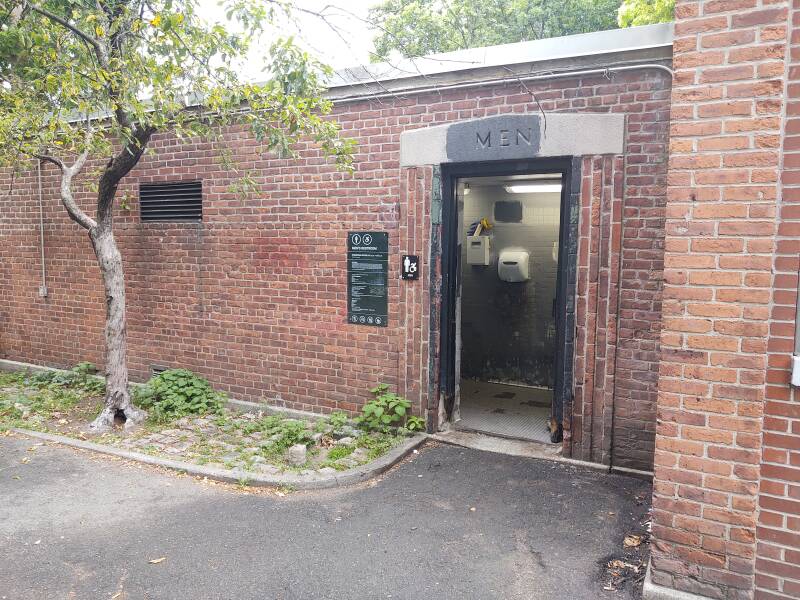
Public toilets in Tompkins Square Park, where ISKCON or the Hare Krishna movement was founded.
By the early 2020s they were quite grim inside.
I have pictures from my first visit in 2012, when they were stainless steel. The bathroom looks much worse now, and since many visitors to this site are looking for pictures of worse rather than better toilets, enjoy:
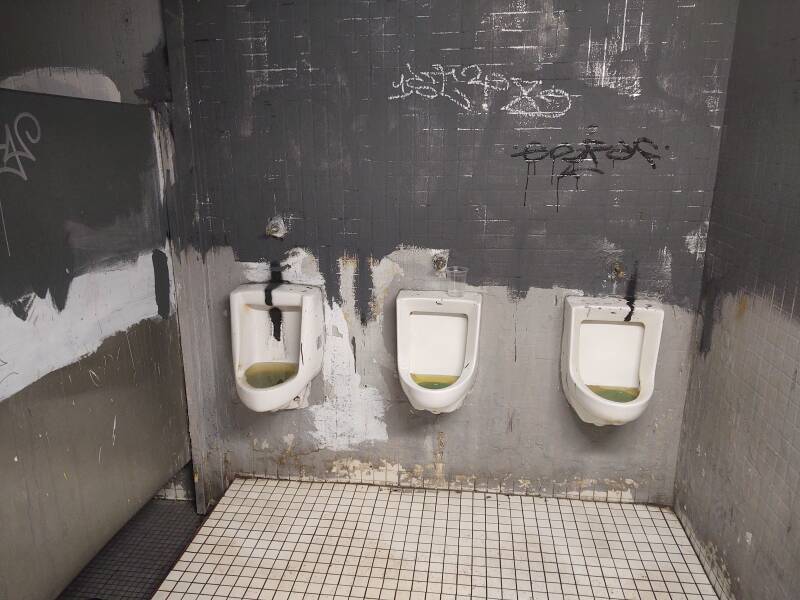
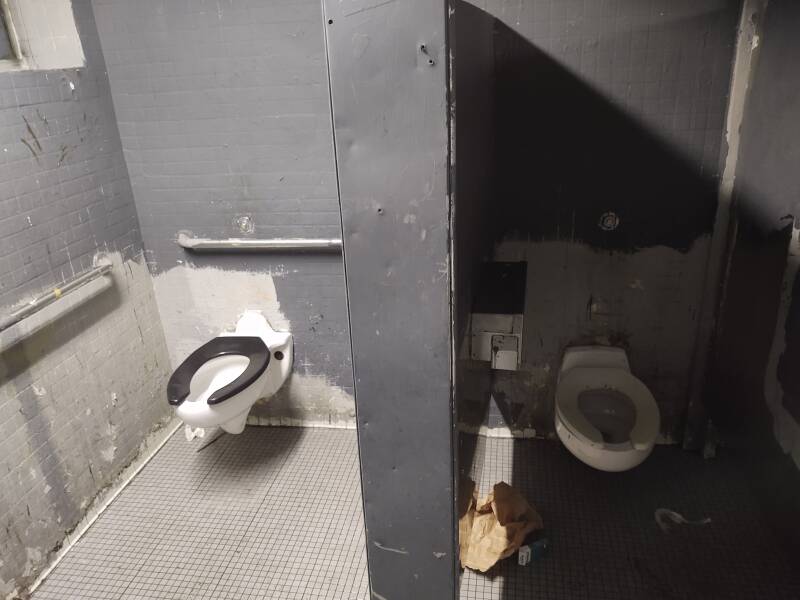
Amazon
ASIN: 0609810340
The original Hare Krishna temple was established on Second Avenue between East 1st and 2nd Streets. The Catholic Worker headquarters is around the corner and down East 1st Street, giving the block a countercultural vibe.

The original Hare Krishna temple on Second Avenue between East 1st and 2nd Streets.
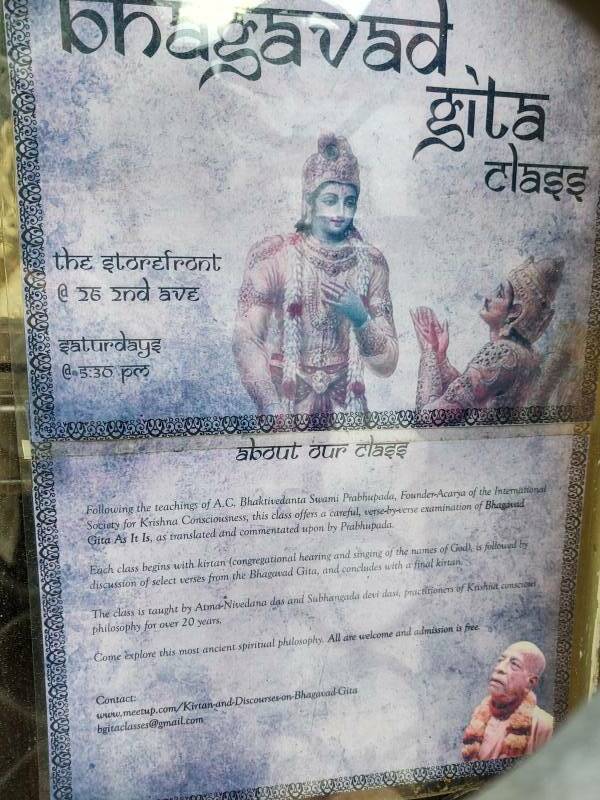
The original Hare Krishna temple on Second Avenue between East 1st and 2nd Streets.
Guesthouses
The Vigilant Hotel is at 370 Eighth Avenue in Manhattan, between 28th Street and 29th Street. It's the five-story building at the center of the first picture below.
I have read that Angelino Sartirano established his first hotel at 116 Gansevoort Street in the West Village in 1888. By 1895 he had acquired hotels at 1553 Broadway, 2291 Third Avenue, 208 Eighth Avenue, 352 Eighth Avenue, and this one at 370 Eighth Avenue.
Flophousesand SROs
The Vigilant was a hotel and then an SRO or Single-Room Occupancy residential building for over a century. SROs used to be common in large cities in the U.S. Usually for men only, each resident had a very small private room, usually just large enough for a single bed. They were usually constructed as "cabins" within a large room spanning the entire floor. The individual cabins had no solid ceiling, but were topped with chicken wire or wooden lattice material for ventilation and so that a few fire sprinklers mounted on the actual ceiling covered all of them.


at Booking.com
By the late 2010s the Vigilant had been converted to budget accommodations for travelers, possibly with a few remaining long-term to permanent residents.
The Interfaith Guesthouse has cabins on the second and fourth floors, and Chelsea Cabins is on the third floor. (in the North American convention of the first floor being the one at ground level)
Both are promoted as hostels or hostel-like, as they are basic low-cost accommodation with some shared space, but both are built in the form of SROs.
Panchagavya, an Ayurvedic elixir of dung and urineAnd, both guesthouses are operated by ISKCON. That means no alcohol, tobacco, or other drugs, and no meat, fish, or eggs. So-called Krishnatarianism is strict vegetarianism, plus avoiding onions, garlic, red lentils, and mushrooms, because Ayurvedic tradition says that those foods increase passion and ignorance.
The door at street level is always locked. You get an RFID key to let yourself in.
There's no elevator and the floors are high, you will ascend plenty of steps. The red bag is at the second floor, and we are looking on up to the third floor. You turn there and then climb to the fourth floor. And if you're a resident, repeat that to get to the fifth floor. All the doors off the stairs onto the floors are also locked, you get a key for those.


Above is the view looking back down from the second floor.
The Interfaith Retreat is true to its name, very inter-faith. Here's the desk on the second floor where a staff member is checking me in.

Here we are on the fourth floor. It has been rebuilt in the original cabin design. The cabins are in the center with a narrow passage around them. There are some windows on the fourth floor.


The price had been just $0.15 per night in 1923 and $0.32 per night in 1932. In the late 1970s the Vigilant was in SRO mode and the Village Voice carried its ads under "Rooms for Rent" for $28 per week.
EV Grieve Forgotten New York Business InsiderWhen I first stayed here in March 2022, the building was in much better shape than it had been when it was described in December 2008, March 2012, and June 2014, when all its floors were occupied by otherwise homeless men, many with mental health issues, and bed bugs swarmed. A cabin then had been $120 to $140 per week, but you wouldn't stay here unless you had no other alternative.
A once very dirty building has been cleaned up, or at least mostly so. Three of the four floors above street level are now a nice place for travelers to stay. But I worry. Something around 90 austere single-room dwellings, 30 per floor, no longer house otherwise homeless men. Compared to Chicago, New York has a much better handle on the problem of homelessness. But still, are those spaces no longer needed?
Here's my cabin. A private cabin with a locking door, nicer than the typical hostel situation. There's a grounded duplex outlet, but it's near the lattice "ceiling". A short extension cord with a multi-tap end is handy, I brought one on my second visit a few months later.


There's WiFi. In the middle of my trip a consulting client made an urgent request. Well, I could do a couple of hours of work there as well as I could anywhere. The work was writing Linux shell scripts for server hardening and automated reconfiguration. Plus detailed documentation explaining how to use the scripts, what the security issues are, and how to explain things to the security auditors.

On a second trip my room was a little nicer, with a proper table and lamp. Plus further in-room reading material.



There's a pleasant shared area on the second floor.

There are also cabins there, so you need to be quiet in the evenings. It enhances the somewhat monastic mood.


Fruit and cereal are always available for breakfast or a late night snack.


As I said, it's literally an inter-faith retreat.

There is Hindu, Christian, and Judaic imagery.

Islam, at least the dominant Sunni sect, prohibits images of living beings, although the Shi'a and Sufi sects are less strict.



And now, more of the reason you're looking at this page:
What are the bathrooms like?
At the Interfaith Retreat the bathrooms are shared, clean, and functional:


American shared bathrooms tend to have very little privacy. It's a moral panic over what people might do in a toilet stall. I was pleased to see that the the ISKCON guesthouse has modified the stalls to provide privacy. There are extensions to the stall walls, a panel above the door, and strips blocking the usual gap on either side of the door.

This includes extended panels at the bottom of the walls and doors.

This this picture is from a visit in March when the weather had turned cold, with temperatures well below freezing and high winds. The extra heat was nice.



Cafe
ISKCON's Rādhā Govinda Temple is at 305 Schemerhorn Street in Brooklyn. As is typical at a Hare Krishna temple, there is a cafe serving lunch Monday through Friday.

Well, I was staying in an ISKCON guesthouse, and I was going to a special exhibit on Andy Warhol's religious-themed art at the Brooklyn Museum, and Govinda's Kitchen was on the way. I should have lunch there.


But first, I'll use the bathroom and wash up.

Look, there's a step stool so children can also easily wash their hands. This is like the improved privacy in the toilet stalls at the guesthouse. It isn't strictly necessary, but it is a nice modification.

Now to get lunch. The cafe had just opened, I was the first patron, so it was very quiet.

Brown lentils, none of those red ones that could increase passion and ignorance.

Further Growth of ISKCON
With ISKCON established in New York, Bhaktivedanta Swami started a second center in San Francisco. He then traveled with his disciples through America, popularizing the movement through sankirtana or street chanting.
A group then went to England, where they soon came into contact with George Harrison. He spoke at length with Bhaktivedanta Swami, eventually becoming a member of ISKCON, and incorporated the mantra into his music, most prominently My Sweet Lord. Harrison also assisted Ringo Starr with writing his song It Don't Come Easy using part of the mantra in the lyrics.
Allen Ginsberg was still involved in the movement, or at least interested and on its fringes. He appeared on the 1968 album Tenderness Junction by The Fugs, chanting the mantra.
Amazon
ASIN: B00005UUVG
Amazon
ASIN: B002L1H0UO
Bhaktivedanta Swami kept traveling, and chanting, and writing an enormous amount. He translated a large body of classic Vedic scripture into English, accompanying the translation with commentary. Bhagavad-Gita As It Is is the most prominent of these.
Amazon
ASIN: 0892131233
Bhaktivedanta Swami prescribed four "regulative principles" for his followers as the basis for their spiritual life and maintenance of the four legs of dharma:
- Ovo-vegetarianism, or the avoidance of meat, including fish, and eggs
- No illicit sex, meaning no sex except if married and done to produce children to be raised Krishna conscious
- No gambling
- No intoxication, including alcohol, caffeine, tobacco and other recreational drugs
The four legs of Dharma or natural law, the behaviors necessary for maintaining the natural order, are;
- Daya or Mercy
- Tapas or Self-Control or Austerity
- Satyam or Truthfulness
- Śaucam or Cleanliness of body and mind
Abhay Charanaravinda Bhaktivedanta Swami Prabhupada, the founder of ISKCON, died in India in 1977.
Disagreement over the movement's continuing leadership led to schisms. It became confusing, like the many variations of Ray's Pizza in New York City — Ray's Pizza, The Original Ray's Pizza, Famous Original Ray's Pizza, and so on. Whichever one you encounter, of course they perceive themselves as the real one and will describe themselves as such. So which is "the real one"? Whichever one you find.
If you're still reading, you would probably like to continue next to the Hindu toilet rituals and regulations from the Manusmṛti.
Or, perhaps, to the overview of the Toilets of Faith.